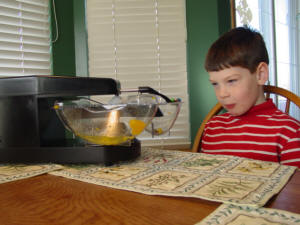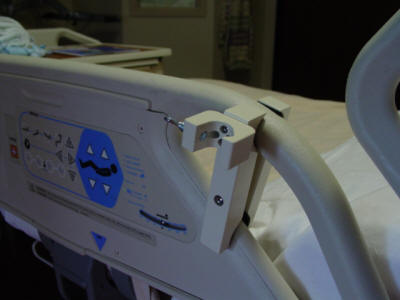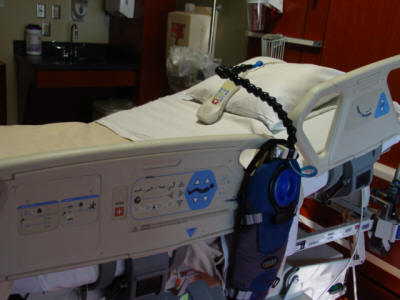March 2019 Independent Eating and Drinking Newsletter
| Independent Eating and Drinking are Wonderful |
 |
| March Newsletter Topics: |
|
| Subscribe to Newsletters |
Independent Eating for Children
From the moment they are born, children start developing skills. Gradually they learn how to sit, walk, talk and feed themselves. These steps are known as developmental milestones and mastery should come during a predictable time frame. However, some children are unable to reach these milestones in one or more of the main areas of development: cognition, social and emotional, speech and language, fine motor skills, and gross motor skills.
Because developmental milestones are achieved in a sequential fashion, mastery of one skill will lead to another. Therefore, if one milestone is missed, the following ones are difficult or impossible to reach. For example, babies first learn to sit with assistance, and then without assistance. A few months later they are pulling up and standing, holding on to furniture. Soon after that they walk independently and then run. Even later they learn to hop, skip and jump. Without the sequential development of these early skills, the infant would not have learned how to run.
These building blocks of learning are very obvious during the first few years of life as infants grow and develop rapidly, and many changes take place. During this time the beginnings of independence emerges. The infant becomes mobile, begins meaningful communication, begins to self-feed, and eventually becomes potty trained, learns to brush their own teeth and bathe with little help.
In normal development, the infant learns how to pick up objects and frequently explores the object with their hands, feet and mouth. As the pincer movement of the hands develops and the fine muscles in the fingers become stronger, the child develops coordination. They become able to pick up food and put it in their mouth and “gum” it into a texture that allows them to form a bolus (a ball of food mixed with saliva in their mouth), and swallow it. Finger feeding is gradually replaced with the use of utensils, but mastery of the use of a spoon or fork can take many months for some children. During this time they frequently will revert back to finger feeding when they become frustrated.
For a child who does not develop the fine muscle control of their hands that is necessary for finger feeding, mastery of handling a utensil is far more difficult. Thus, the building blocks necessary to evolve into an independent eater are interrupted and the child misses out on experiences that will help them develop in many areas, not just independent eating. Children who are unable to put “things” (toys, food, fingers and toes) in their mouth do not develop their tongue and mouth muscles at the same rate as their peers. They also do not harden their mouth to the touch of different textures in the same way that their peers do.
It is important that children with developmental delays master as many skills as possible during a similar time frame as their peers. For many, those skills are difficult or impossible to reach in the traditional way. However, with the help of assistive technology (AT) many times those skills can be acquired. For example, independent mobility can be achieved through the use of walkers, wheelchairs, or a variety of other products. With the support of AT, the child is able to explore and gain knowledge and experience in their natural environment. Communication can be supported with sign language or communication aides.
However, eating is more difficult to facilitate. Food comes in assorted shapes and textures, some of which are eaten using fingers and others that require a spoon. Many children with developmental delays eat soft textured food for a longer time than their peers because their oral motor skills are inadequately developed for them to safely eat textured foods. This creates a situation where a child who is experiencing difficulties with gaining independence eating, needs to eat soft textured foods that are difficult, if not impossible, to eat using fingers. Therefore, for them, the simple act of getting food into their mouth independently becomes complicated by the need for a utensil.
Comparing picking up food with your fingers and placing it into your mouth with picking up food on a spoon and placing it in your mouth, illustrates the increase in complexity of the task that occurs when a spoon is needed. A simplistic description of the external body requirements is as follows: when finger feeding, the child needs eye hand coordination to locate the food, a finger/thumb pincer movement to pick-up the food, a small amount of wrist rotation, and enough elbow flexion to raise their hand to their mouth. When using a spoon, the child first needs to be able to grasp the handle of the spoon. Once they have the spoon in their hand they use eye hand coordination to locate the food (usually contained in a bowl) and they must manipulate the spoon into a bowl and move it around in the bowl so that food is either intentionally or accidentally loaded onto the spoon. This action typically requires significant wrist rotation. Next the spoon must be raised to the child’s mouth. To retain more than just a coating of food on the spoon, the bowl of the spoon must be kept on a level plane while the spoon is being raised from the bowl to the mouth. This is a very complicated movement that requires at a minimum both wrist rotation and elbow flexion. Normally, the arm is also raised at the shoulder and some shoulder rotation is evident. Throughout this process the child must maintain a grasp on the spoon. The entire event of taking a single bite of food using a spoon is dramatically more complicated than taking a bite of food using your fingers and requires a higher level of cognitive processing, and the coordination of many more muscles and more energy.
Many parents, and the medical professionals supporting them, are so concerned about learning how to provide care and support for a child who is identified as having developmental disabilities, that their main concern about eating is providing adequate calories (or nutrition) in a timely fashion (unless a child has a significant eating disorder). They are busy with so many issues that the child becoming an independent eater is not a priority. However, the child is missing out on experiences that will help them achieve developmental milestones. A simple example of this is choice making. If a child self-feeds, they can easily show their preferences in foods. They either do not eat the food items that they don’t like, or, more commonly, they simply drop it onto the floor. They are selecting what they will, and will not, eat. They are making choices, which is healthy for them in developing their independence.
It is desirable that the transition from feeding to eating be a natural evolution for a child with developmental disabilities, as it is for a child without disabilities. Children, who are fed out of necessity beyond the normal developmental time frame, in many cases, continue to be fed rather than learning how to eat. This is an easy oversight on the part of the person feeding the child. It is simple to continue doing what you have done since the child started eating solid foods. Yet if food is put in the child’s mouth without them actively participating in removing it from the spoon, they will not be given the opportunity to practice, and therefore they will not become good (i.e., develop the skills) at closing their lips around a utensil.
Good lip control contributes to clear speech. Lip closure should be encouraged and when necessary, demonstrated and assisted. Always explain to the child what you are doing and why. Initially, to assist with lip closure, the person feeding can use the thumb and index finger of the hand that is not holding the spoon, to gently close the lips of the child over the bowl of the spoon. The spoon is then gently removed from the child’s mouth. During the removal process an upward movement of the spoon should be avoided as it wipes the spoon on the top teeth/gums of the child. Once lip closure begins to evolve the next step is to develop the child’s ability to move their mouth onto the spoon and then close their lips. At this stage the person feeding should still remove the spoon from the child’s mouth. However, as the child exhibits their ability to move onto the spoon to take food, they should then be encouraged to move back, away from the spoon, with their lips closed, so that they take the food off of the spoon and keep it in their mouth. All of this is more easily accomplished when the child is positioned appropriately for eating and is able to produce a chin tuck when taking food from a spoon. Mealtime Partners January 2019 Newsletter provides more information about good positioning for eating.
For many parents this process is slow and frustrating. It can create tension and stress at mealtimes that is very undesirable for both parent and child. To avoid creating a negative environment, they can work on feeding for the first few bites of every meal when the child is hungry.
When a child is being fed it should be remembered that they are unable to physically choose what they eat and it is up to the person feeding them to give them the opportunity to select what they will eat. Always respect their rejection of food, as long as they have had a taste of it. Allow them to communicate that they do not want what is being offered or that they would like more. Mealtimes are a wonderful opportunity for communication and if given the chance, children will let you know what they want.
| Independent Eating in School | |
|
For many students setting meaningful goals needs to include assistive technology (AT). Individual Education Plans (IEP) should include the AT that can help a student reach important goals. For those students who are working on reaching functional goals for independent eating, the Mealtime Partner Assistive Dining System can be included in the IEP. To be able to feed yourself is a huge step towards gaining independence and a very worthwhile and significant goal! The Mealtime Partner Dining System easily serves most table foods and has very reliable food pickup. It is the only device of its kind that accommodates small children. It is portable and easy to setup and use in both school and home environments and will provide reliable operation for many years as they grow. |
 The Mealtime Partner Assistive Dining Device Positioned on a Table |
| For additional information, please call us at 800-996-8607, or email our staff for assistance by clicking here. | A four year-old can easily use a Mealtime Partner Dining System to learn to eat independently. For more information about this dining system, click here. |
The Hospital Bed Hydration System
Most of us have ended up in the hospital at least once in our lives. Many hospital stays are scheduled and are to treat minor problems. With the current standards set by insurance companies for payment, many hospital visits are for day surgery and the patient is in and out of the hospital in just a few hours. However, for those visits that are an emergency and/or to treat very serious difficulties, everything is different. First, patients may start out in the Emergency Room and later be moved to another section of the hospital depending upon the type of treatment they are to receive and the level of care necessary. This might include being in Intensive Care, Cardiac Care, or a Surgical Unit. Many of these patients do not initially take food or liquid by mouth, instead they receive all hydration and nutrition intravenously, but over time they resume, first drinking by mouth, and then eating by mouth. For many, reaching for a cup and lifting it to their mouth, even if a straw is available, is a very demanding task, if not impossible. Consequently, they are dependent upon other people to help them. Frequently, the result is that they do not consume enough fluid.
Consuming an adequate amount of water is a critical component of recovery from surgery, illness or an accident. Dehydration significantly impacts the body’s ability to heal. Without an adequate intake of water, patients heal more slowly and/or develop secondary complications. However, in many cases attaching equipment such as drinking systems or Sip N Puff control systems (etc.) to the intelligent beds used in these high-care units has proven unsatisfactory. Because the bed rails for many of the new beds are made of molded plastic to accommodate the electronics that make the beds so capable, clamping equipment to the rails has presented a problem. Using commonly available clamps, the plastic bed rail begins to compress due to the clamping pressure and the clamp does not maintain its position over time. Thus the equipment shifts its position and soon becomes unavailable to the user. Mealtime Partners now offers a Hospital Bed Clamp System (MtP part no. 4980) that solves this problem. It uses both the top and bottom bed rails to distribute the clamping pressure over a much larger area and, thus, will hold its positioning indefinitely. An Attachment Holder is fastened to the clamp body and permits various shaft sizes to be held securely. Thus attaching a drinking, or other type of system is easily accomplished.
The Attachment Holder that is fastened to the side of the Hospital Bed Clamp, as shown in the illustration below holds the Flexible Tubing that is part of the Hospital Bed Hydration System (MtP part no. 6550). The Attachment Holder is held on the clamp body with two screws and can be rotated 90-degrees, so the device it is holding can emerge in either direction. Also, the clamp can be mounted with the Attachment Holder on the inside or outside of the bed rails. (Two tools are provided to easily accomplish these changes.) A thumb screw is used to hold the flexible tubing that holds the Drink Tube in place so that it can be quickly removed for cleaning or patient care without tools
 |
| Hospital Bed Clamp with Attachment Holder |
The Mealtime Partners Hospital Bed Hydration System provides a stand-alone hydration system for the intelligent hospital beds described above. The system provides drinking tube positioning using a tube positioning conduit, to hold the drink valve close to the patient’s mouth for easy access. Everything that is needed to add drinking to an intelligent bed is included with this system. The bladder that comes with this system holds 100 ounces of liquid. Therefore it does not have to be refilled as frequently as a cup, saving hospital staff time. This hydration system makes a drink readily available to patients through the day and night.
 |
| The Mealtime Partners Hospital Bed Clamp System with Sip N Puff and Drinking Tube |
For information about all of the Mealtime Partners Drinking Systems, click here, or call 800.996.8607.
|
Did you know? Did you know that the sounds that we produce to make speech have evolved due to our diet? Over the past 300,000 years, the alignment of our teeth and lips has changed. Infants have an overbite at birth. When people were hunter-gatherers, as they matured they used their teeth as tools, as well as to bite and pull food. This caused the upper and lower teeth to become aligned and the overbite to disappear. As life styles advanced more foods were processed (e.g., grain was ground up) and became softer. With the advent of softer foods, and the development of tools, teeth were not required to align for man to survive. The overbite that existed at birth remained throughout life. The structure of the jaw, and how the teeth interacted with the lips, allowed consonants like “f” and “v” to be produced. Put your teeth together and try to produce these sounds keeping the teeth together to understand how difficult it would have been without an overbite. To find more information about these findings read the article in the journal Science Human sound systems are shaped by post-Neolithic changes in bite configuration which described the findings in detail . |